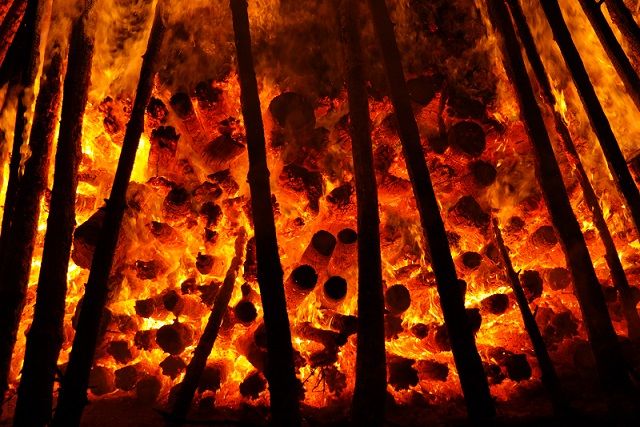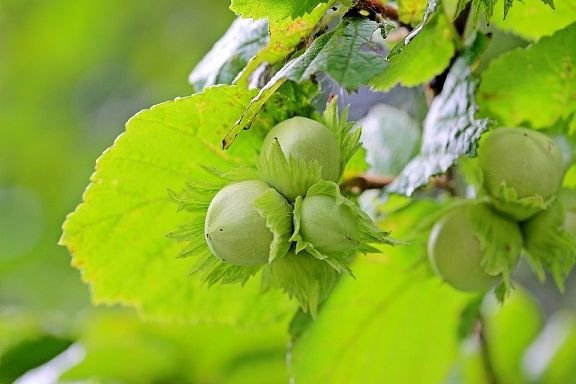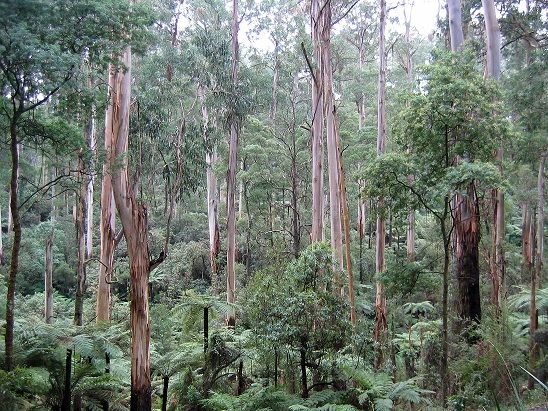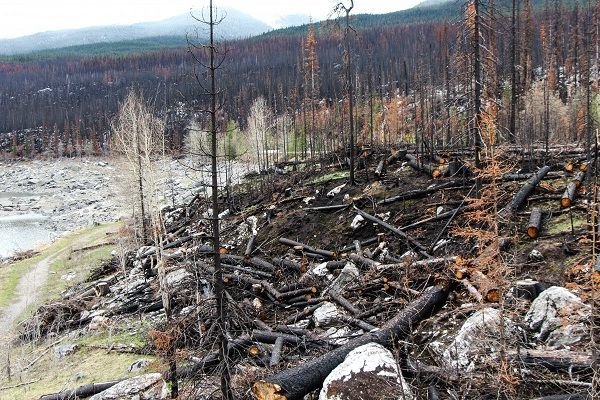Components of fire and their effects on the soil seed bank

Good day to my dear readers and welcome to another episode on the seed bank series. In the first episode, I introduced the topics and various factors could affect the seed bank while the dynamics surrounding the fluctuation of the soil seed bank was discussed in the second post on the topic.
We all know that fire outbreaks in forests are common occurrences in various parts of the world. In what ways do these fires affect the soil seed banks of the various forests and what is the implication of these effects on the regeneration of such forests? The answer can be explained in various dimensions.
Basically, there are three major components of forest fire; the heat, the smoke and the ashes that result from burning of biomass. These components have been found to have varieties of individual and synergistic effects on the seed stored in the soil as the seed bank.
Just for the general knowledge of it, the transfer of heat to soils in natural ecosystems can be due to two main factors;
Direct radiation from the sun increases the temperature of the soil especially in the communities with few or no herbaceous ground cover. The magnitude of radiation transferred to the soil can be greatly reduced in the forest communities with abundant trees in which the crowns are more or less touching except in areas in which gaps are present and herbaceous layer few or lacking.
Heat is also transferred to soil during forest fires which subsequently affect the physical, chemical and biological properties of the soil. Researchers have shown that soil heating as a result of forest fire increases the seedling density of the seed bank of the soil. Forest fire heats up the forest soil which results in temporary elevation of the soil temperature. Consequently, the soil seed bank is affected which in turn affects the species composition, seedling density and rate of seedling emergence from the soil seed bank.

Like I have previously put in the past episodes, the presence of buried viable seeds in the soil is commonly associated with a phenomenon of dormancy, which prevents the seeds from germinating even under favourable environmental conditions. An example is found in the group of plants known as legumes where seed coat impermeability to water, also called hardseededness causes dormancy and is a major factor in promoting the formation of soil seed banks in leguminous species. Different species of plants have developed a range of seed dormancy strategies that allow dispersal prior to germination, and prevent germination when conditions are unfavourable for establishment. In reality, fire has been reported as a common trigger for breaking this dormancy. By minimizing germination prior to a fire, and maximizing germination following fire, germinants increase their chance of survival.
The direct effect of heat from fire is one well-known factor that stimulates germination of fire-responsive species. It was originally assumed that heat from fires cracked seed coats and allowed germination to proceed according to a research. In recent years, however, a number of other fire products have been found to be influential as well. These include charred wood, extracts of charred wood, ashes and plant-derived smoke. The potential significance of smoke is illustrated by the fact that it increased seed germination in 45 out of a total of 94 Western Australian species that were
normally difficult to germinate.

In order to prove the above assertions, an experiment was conducted to assess the smoke and heat effects on soil seed bank germination for the re-establishment of a native forest community in New South Wales. Soils from the forest’s floor were collected and subjected to seed bank analysis procedures during which heat and smoke situations were simulated in the laboratory. The results suggested that increased seed germination in the field immediately following a moderate intensity fire may sometimes be the result of smoke stimulation or sometimes the result of heat stimulation of the soil seed bank.
In another separate experiment conducted to examined the separate effects of heat, smoke and ash on seedling emergence from the soil seed bank of heathy Eucalyptus woodland in Grampians National Park, Western Victoria, researchers found greater emergence from smoke or heat-treated soil. It was observed that unless fire frequencies are high and kill fire-sensitive obligate seeders before they reach maturity, the chance that the soil seed bank could substantially alter vegetation composition within an area after fire is low. The study also showed that a major shift in the successional pathway after fire due to altered seed bank composition is unlikely in vegetation; most species not recorded in the seed bank of the study site are either resprouters (obligate or facultative) or serotinous, suggesting that they will readily regenerate following fire.
On the contrary, results from several works have suggested that soil seed banks can exert a strong influence on the path of vegetation succession following fire, with species varying in their capacity to persist in the seed bank over time, leading to changes in seed bank composition and propagules available for post-fire colonization. However, no significant trend has been observed in the similarity between the extant vegetation and the soil seed bank with time since fire.
In a particular experiment, a total of 32% of the species recorded in the soil seed bank were not present in the above-ground vegetation at the same site, suggesting that some species requiring fire for germination may be present in the seed bank. Most species present in the extant vegetation were not recorded or were in very low abundances in the soil seed bank. Therefore, the mode of regeneration appears to be the major determinant of species absence in the soil seed bank as evidenced by a research in which 66% of species occurred in the extant vegetation but not in the seed bank have the capacity to regenerate by resprouting.
What happens after fires?

The capacity of species in fire ravaged communities to establish seedlings after fire from seeds in a soil seed bank is influenced by several factors including;
- magnitude and duration of high or elevated temperatures during fire at soil depths
- magnitude and duration of high or elevated temperatures during fire in microsites where viable seeds are
located - seed germination responses to elevated temperatures.
Results from study has suggested that small-scale spatial variation in temperature exists at the soil surface during fires, and that low-temperature patches are essential for seed survival on the soil surface. Seed survival is more likely and more predictable at 2 cm depth in the soil, because soil temperatures during fires were relatively low, and varied little
from site to site. Although higher proportions of seeds should survive through fire at this depth in the soil, some seed mortality must occur, because lethal temperatures were occasionally reached. Soil temperature at 2 cm has been reported to be approximately 80 °C during a moderate intensity fire.
The response of plants to heat could depend on the species or taxa. Plant species from several ecosystems have demonstrated positive germination responses after being exposed to temperatures typically reached during fires. Taxa or functional groups with this response include legumes in the southeastern United States, California, and Australia; obligately seeding shrubs in California chaparral and in southern France and annual species in California chaparral. Other species, however, have responded to elevated temperatures with decreased or no germination. Some functional groups that have demonstrated this response are herbaceous perennials and other species that do not establish seedlings after fires.
The status quo
In Nigeria as it is in several parts of the world, bush burning or slash and burn is a common agricultural practice among farmers. At times, the fire goes beyond control and spread into the nearby bush or forest and leads to what can be called an accidental forest fire. Forest fire moreover, could occur when hunters deliberately set forests on fire to drive out games. Food and Agricultural Organization also recommends prescribed burning as a forest management tool in order to remove the accumulation of fuel loads that would otherwise lead to damaging wildfires. Whether natural or for agricultural, hunting or management purposes; forest fires affect the soil seed bank parameters like the species composition, seedling density and rate of seedling emergence.
Summary
The components of fire varies depending on the type of vegetation. Generally, heat, smoke and ashes happen to be major components of many. These components have varying effects on the seed banks of forest or vegetation's soil and these effects are consequential for the regeneration of forests after fire outbreaks or controlled burns. Smoke and heat stimuli which are both the consequences of forest fire among other products have been found to be somehow complementary in their promotion of seedling emergence from the topsoil seed bank, especially when dormant seeds are copious within the soil.
Thank you for reading.
References
__

Wow! This article is extremely detailed and I was able to learn a lot about the forest fire. I would definitely go to read the previous post on this
You should! Thanks for the audience
Finally had time to read your post, I was really interested, especially since my country just got scorched last summer because of forest fires, I always wondered how plants would regrow after forest fires, I always thought the roots stayed alive and the plant regenerated trough these, now I know it's because of soil seed bank and the stimulus is fire and smoke.
Wait this is legal in Nigeria??
Can you explain this part a little better, I think I've never heard about it.
Never thought possible for seeds to survive at that high temperatures, and to actually use the heat and smoke as a stimulus for germination is amazing!
Keep doing these types of posts, I was never much into plants/forest science, but I'm learning so much from you
Yeah,this really interesting post @shaid,i wish you can mentor me on how write a very good post on steemstem or science. i need your encouragement. Thanks
feel free to contact me on discord.
Can I tag along too, I need a hand too. You write like an academic. I sure would like if I can get mentored too.
feel free.
Technically, yes. Since there is no law/policy prohibiting such and if there are (I really dont know of any), I've never seen anyone being punished for such action.
When fuel loads is allowed to accumulate in forests, it increases the likelihood of damaging wildfires occurring. However, fuel loads are burned in a kind of 'controlled burn' either within the forest itself or in a chosen location, it greatly reduces the chances of damaging wildfire occurring within such forest. Hence, fire is a major forest management tool